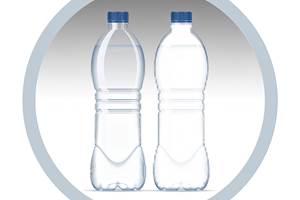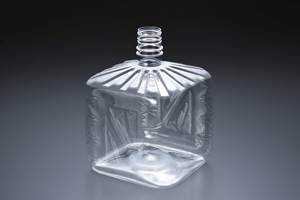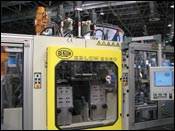New PET Stretch-Blow Machines & Applications Debut at NPE
Close Up: Stretch-Blow Molding
Italian stretch-blow molding machinery builder Siapi (siapi.it) had a lot to talk about at NPE2012 last month in Orlando, Fla.
Italian stretch-blow molding machinery builder Siapi (siapi.it) had a lot to talk about at NPE2012 last month in Orlando, Fla. That included a new series of two-stage (reheat) stretch-blow machines for custom bottles, with options such as a new, flexible neck-orientation system for oval or oblong shapes. Also new were several unusual PET applications, including conversion of 5-gal water coolers from polycarbonate (PC) to PET and conversion of large stackable containers from HDPE to PET, thanks in part to new-generation, ultralight preforms. There’s also news in PET wide-mouth containers.
NEW MACHINES FOR CUSTOM BOTTLES
Siapi (represented here by Siapi America Inc., Norcross, Ga.) builds only all-electric reheat stretch-blow machines. Its two latest models are the linear EA4 and EA7, which accommodate two to 10 cavities and offer new options and kits aimed at demanding custom containers such as for cosmetics and household chemicals. These machines (and others in the line) can be equipped with Siapi’s newest advanced IR oven banks, said to save energy and optimize material distribution in the bottle. Additional precision in material distribution and weight savings of up to 15% reportedly can be achieved on oval and oblong bottles with a preferential heating option. Unlike competitive systems, there is no cycle-time penalty with this preferential
heating system, Siapi states.
Specializing in quick-change bottle format flexibility, Siapi has further improved its machine changeover process by reducing the number of change parts, using tool-less quick-release systems, and employing mold-change cart systems. The results are said to be even faster changeovers with minimal investment and reduced need for staff training. A complete machine changeover, including blow molds and change parts, can now be done in as little as 30 min.
Siapi has also expanded its custom bottle capabilities with its new IndexMatic flexible neck-orientation system, which is available in three configurations:
•Neck orientation coupled with preferential heating is suited to custom bottles with oblong or oval bodies. The preforms must be positioned in the mold with the same orientation, using special geometry on the support ring. The orientation system is easily accessible for quick changeovers between neck finishes and formats. Again, unlike competitive systems, there is no impact on cycle time, according to Siapi.
•Neck orientation without preferential heating provides precise and repeatable positioning of neck finishes on round or square containers with respect to two key bottle axes.
•Bottle exit orientation system aligns and delivers oval and oblong custom bottles so they exit the machine in a consistent orientation. This is necessary for automated bottle palletizing and for feeding directly to inline filling, labeling, and case packing.
DEVELOPING NEW APPLICATIONS
More than 50% of Siapi’s installations in the last two years have been for producing large containers of 5 to 40 liters in one to five cavities. Machine models for such applications can produce up to 5500 bottles/hr of 5L size and 1500/hr of 20L. Siapi’s EA2S machine is described as “superflexible” because it can run 20L in two cavities, 10L in three cavities, or 5L in five cavities, simply by changing the mold and selecting the appropriate software program on the control panel. The EA2S and single-cavity EA1S can utilize Siapi’s HandleMatic system for automatic insertion of an injection molded PET handle during the blowing phase.
For the U.S. market, Siapi recently developed a 5-gal PET water-cooler bottle with an inserted handle as a conversion from PC. The PC standard weighs 760 g and has wall and base thicknesses of around 1 mm and 2 mm respectively. The PET container weighs 680 g and has wall and base thicknesses of only about 0.8 and 0.5 mm. Still, the PET container has a topload strength of 135 kg (297 lb) vs. 90 kg (198 lb) for PC, and the PET bottle’s light transmittance decreases only 6% after 10 washing cycles, vs. 15% for PC. The PET bottles passed a 1.2-meter drop test 100% of the time, before and after 10 washing cycles, while PC bottles passed only 60% before washing and 50% after washing.
Even more recent is an ultralight 5-gal water cooler for one-way use that Siapi created from new-generation preforms as light as 330 g. The finished container has a wall thickness around about 0.45 mm and base thickness around 0.4 mm. Its topload strength is 120 kg (264 lb)—still one-third higher than
a PC bottle weighing 130% more.
Large PET containers of such light weight require careful bottle and preform design and extremely accurate reheat and stretch-blowing processes. Siapi has collaborated with COMSOL Group (comsol.com, U.S. office in Burlington, Mass.), a supplier of finite-element mechanical simulation software to design large, ultralight PET containers.
However, Siapi notes that bottle design itself is not sufficient to guarantee performance of ultralight containers. It is necessary to engineer the complete process, including preform design and the processing parameters, to achieve consistent minimum wall thickness necessary to prevent bottle deformation. Thus, Siapi is also working with Agr International, Inc., Butler, Pa. (agrintl.com), using Agr’s PETWall Profiler to manage the production process for very fine wall-thickness control. (See K 2007 story referenced under "Editor's Picks" above right.)
Another area of recent application development for Siapi is large stackable PET containers with square bases and volumes of 10, 16, or 20 liters. Developed initially for the North European market, such containers are said to be arousing interest now in North and Central America for edible oils and for the
chemical industry.
One recent example was conversion of an HDPE container for environmentally friendly fuel to PET with a weight reduction of 50%. A special design allows the containers to be stacked four high.
In general, Siapi says, 20L stackable containers can weigh 480 to 500 g in PET vs. 900 to 1000 g in HDPE. Wall and base thicknesses are around 0.6 and 0.5 mm respectively for PET vs. 2 mm for both in HDPE.
Siapi also has been developing its EAWM series of widemouth container machines since 2004, largely in response to requests by North American customers. These machines can mold containers up to 12L with neck finishes up to 180 mm diam. in one to four cavities. A major project in North America converted a 500-ml PET jar with a 70-mm neck finish from single-stage (integrated) stretch-blow molding to two-stage reheat technology.
The driving force behind this move was a reduction in container weight of almost 30%. Siapi helped develop the container design and optimize the preform profile. This jar can be molded on Siapi machines at up to 4800/hr.
Related Content
How Was K 2022 for Blow Molding?
Over a dozen companies emphasized sustainability with use of foam and recycle, lightweighting and energy savings, along with new capabilities in controls, automation and quick changeovers.
Read MoreMold Opaque White PET Bottles – Without Pigment
Trexel and Husky are cooperating on molding recyclable opaque white preforms for PET bottles, which provide a light barrier using foam instead of pigment.
Read MoreModified Machines to Mold Unusual PET & PP Bottles at K 2022
K 2022 visitors looking for new ideas in stretch-blown containers will be treated to two novel collapsible concepts a the Nissei ASB booth.
Read MoreCoca-Cola Europacific Transitions to Tethered Caps and Lighter PET Bottle
Sidel is converting all Coca-Cola PET bottling lines in Europe to meet new EU packaging regulations by July 2024.
Read MoreRead Next
K 2007 Blow Molding: Electric Machines Take Hold
Development of all-electric and hybrid-electric blow molding machines may be gaining momentum, as evidenced by several new models introduced in Dusseldorf.
Read MoreLead the Conversation, Change the Conversation
Coverage of single-use plastics can be both misleading and demoralizing. Here are 10 tips for changing the perception of the plastics industry at your company and in your community.
Read More


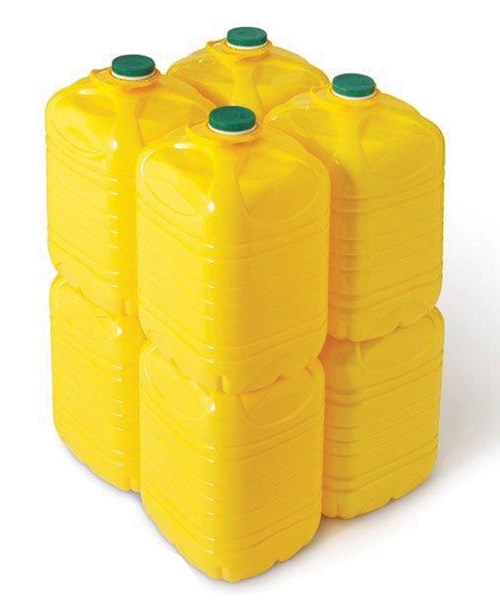
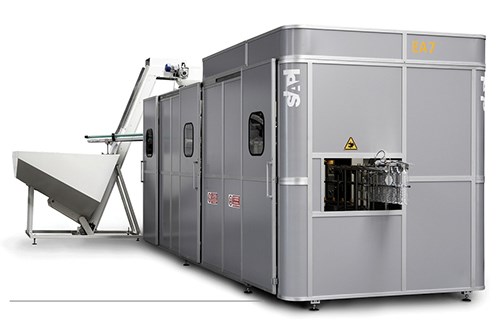
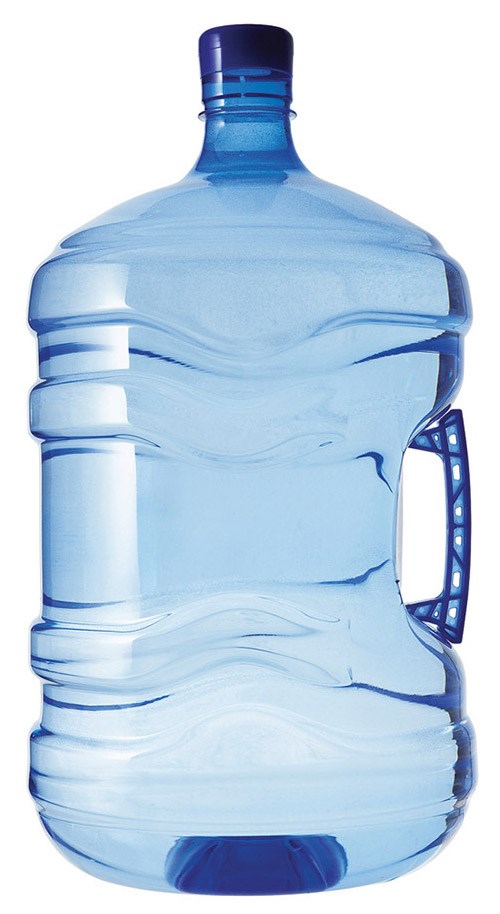








.png;maxWidth=300;quality=90)













